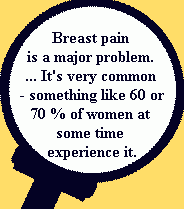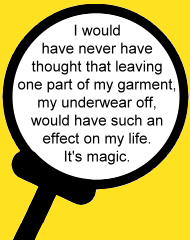
|
|
The British study on bra wearing and breast painIn year 2000, two breast surgeons started a study including 100 women at two breast clinics (all of whom had breast pain) and found that over half of the premenopausal women with pain found relief when they quit wearing bras for three months. For some the pain relief was very dramatic, changing their lifes. When they resumed bra wearing for the last three months of the study, the pain returned. Besides the pain data, the doctors also showed video thermography footage that dramatically demonstrated the heat build-up from bra wearing, and they discussed the possible connections with cancer causation. They also made a documentary film that was shown
on nationwide television in Britain. The following is
a press release from Channel 4 UK (England), for the documentary on the
connection between bras and breast pain. BRAS - THE BARE FACTSThursday, November 2, 10pm What follows is a press release and a partial transcript of the British documentary Bras, Bare Facts, which was aired at Channel 4 (UK) on Thursday, November 2, 2000, at 10 pm. BRAS - THE BARE FACTSIs it habit, modesty, support or just plain sex appeal that has convinced women that wearing a bra is essential? In the '70s, some women burnt their bras as a sign of liberation, now Dispatches asks if women should go without in the interests of wellbeing. While bra fitters claim that bras stop sagging, medical experts are beginning to examine the down side of wearing a bra. Bras have become the essential female garment. At the same time, breast problems have been increasing. At least two out of five women suffer from pains in their breasts - some also suffer from cysts. In the name of fashion, breasts have been pushed into all different shapes and sizes - but for women living with breast pain, it's no joke. "Breast pain affects you on so many different levels - things like picking your children upit hurts so much," says one woman. "It hurts to walk along a street. You just feel miserable all the time," says another. Experts agree breast pain is a serious problem for many women. "It can be very debilitating. I know women who are unable to work because of breast pain. It's very commonit's very hard to treat," says Professor ROBERT MANSEL of the University Hospital of Wales in Cardiff. The biggest worry of course is breast cancer. Most research looks for an explanation in hormones, genetics and diet, but one man has a simpler solution - he claims that breast cancer could be connected with wearing bras. Medical anthropologist SYDNEY SINGER likens the wearing of bras to the ancient practice of Chinese foot binding. "The purpose [of bras] is to bind the breast. There is nothing good about them - our culture has turned breasts into fashion accessories" he says. While Singer's theories are not supported by scientific evidence, some breast specialists are sceptical about the function a bra performs. Professor Mansel says there is no evidence that bras are good for your health: "There's no positive evidence that wearing a bra is good for the breast." There has been little research into the causes of breast pain so Dispatches commissioned its own research from a team of medical experts who looked at the possibility of a link between it and wearing a bra. They asked a group of women suffering from breast pain to live without their bras. The women were required to report back on any changes they experienced as a result of going without. For many, the results have changed their lives, and led the doctors involved to call for further research. Dir: Jill Nicholls Prod: Martin Weitz Prod co: MBC/Focus Productions |
|
***********************************
Narrator -- In the 60s and 70s, women took off their bras as a gesture of liberation. We got a hundred more women to do the same thing for science. All their lives women have been
told that bras are good for their breasts and good for their looks, but is it true? Tonight, some are going to find that the effect of taking off their bra can be surprising. |

|
Dr. Robert Mansel -- "When one looks at where there's positive evidence that bras are good for health, that evidence does not exist, because the groups that don't wear bras, the civilizations of people who don't wear bras, tend to be from the groups having lower breast cancer incidences. There is no positive evidence that bra wearing is good for the breast. Cysts and pain are areas where the facts really are quite sparse. I think the right thing is to do the experiment and see if there's any effect, and that's exactly why I've gone into this enterprise. Breast pain is a major problem. We've been studying it for 25 years now. It's very common - something like 60 or 70 % of women at some time experience it. And it's very hard to treat and so those features alone makes it a very important problem." Narrator -- What could link the work of these doctors with Singer's is not cancer, but much more common though far less publicized complaints like breast pain and cysts.
Marian Gooden -- "I just seem to grow them, like people grow weeds in their garden. It's almost like a toothache in your breast. They become incredibly painful. You sort of walk around almost holding your breasts, because you are trying to ease the pain in your breasts." Dr. Mansel - "We've got stretching of the breasts ligaments and drooping in later life, that occurs very regularly anyway, and that's a function of weight, often of the heavy breast, and those women are wearing bras, but it doesn't prevent it." dr. Mansel -- we know that wearing a bra, the breast is hotter, and there have been studies done of measuring breast skin temperature and it can show hotter areas and cancers are associated with hotter areas of course." |

| Marian Godden - "For me, this whole trial has been magic, absolute magic. I would have never have thought that leaving one part of my garment, my underwear off, would have such an effect on my life. It's magic. I can't see me ever wearing a bra again." Narrator - On average in the pre-menopausal group the study reveals that the number of totally pain-free days went up by 7 percent, which the doctors regard as significant for a problem that is otherwise so hard to treat. On the other hand the study yields no useful statistics about cyst formation. Nicholls -- "The positive result was that the pain is a lot easier. It was a definite difference by not wearing a bra." Narrator -- The trial does point to a possible link between wearing a bra and breast pain among the women still having periods. That could have wider significance. Several other studies have shown a link between breast pain among pre-menopausal women and breast cancer. Researchers in Paris, for instance, have found that women with monthly breast pain have double the risk of getting breast cancer. Statistically, they say, pain is as significant a risk factor as a family history of cancer. Prof. Jean-Christophe Thalabard, Univ. of Paris Hospital -"The reason why we were astonished by the results (is) the fact that usually when we look at some risk factor for breast cancer, the order of magnitude is 1.1 or 1.2. It's not so high, I mean. When you go to 2 and above (double the risk, which is what they found for breast pain), it usually deals with familial factors, personal history of breast disease, but not for, I mean, common clinical symptoms. So it was for us something which was astonishingly high." Narrator -- The trial in Bristol and Cardiff indicates nothing about the onset of cancer, only that breast pain might be relieved by not wearing a bra. But even that could be useful. Dr. Thalabard -- "I would say that reducing breast pain is an objective by itself, because you need to have a normal life without pain. And if it turns out that it is really connected with a reduction of breast cancer, it might be very important from a public health point of view." Narrator - The fact that the bra can contribute to making the breast hotter could also have wider significance. Prof. Hugh Simpson, a cancer specialist in Glasgow, invented something called the Chronobra, specifically to measure changes in breast temperature during the menstrual cycle. Professor Hugh Simpson, Glasgow Royal Infirmary -- "The temperature difference, the circulation difference between the pre-cancerous breast, the breast that going to get cancer, (and) the normal breast is a half a degree centigrade. The pre-cancerous breast is a half a degree warmer. And this enables us to pick up the women who we know are at high risk with about a 90% certainty. But the constricting things (like bras) which raise the temperature of the breast too high are theoretically a risk factor for breast cancer. I think anything which increased the temperature of the breasts must raise our eyebrows slightly." Dr. Mansel -- "The fact that the breast is hotter wearing a bra may have a theoretical effect and it may be a very small effect, so I find it very difficult to give women definite advice based on the current data." Cawthorne -- "But not forget that the vast majority of women who come to breast clinics don't have breast cancer. And a lot of those are suffering from pain, and perhaps don't need to suffer, simply by avoiding wearing a bra." Narrator - Though limited, the research responses suggest the need for further studies into what the bra could be doing to the breasts. But the general manager of Playtex does not believe that they are in a position to do that research. John Dixey, Playtex executive -- "I don't think it's possible to actually do research into the medical side of wearing a bra because it's not really, we're not doctors, but we certainly listen to any advice that comes across or anything associated with wearing a bra, but categorically I could state that we've no previous knowledge of any medical problems with anybody wearing a bra, and I think that it's just hearsay from people who are non-professional." Narrator - Simon Cawthorne is confident that the research they have done has shown enough of a link between breast pain and bra wearing to justify further studies. Rae Marsh -- "I had no idea that for me to get rid of the pain was to get rid of wearing bras. It was a huge breakthrough." *********************************** |